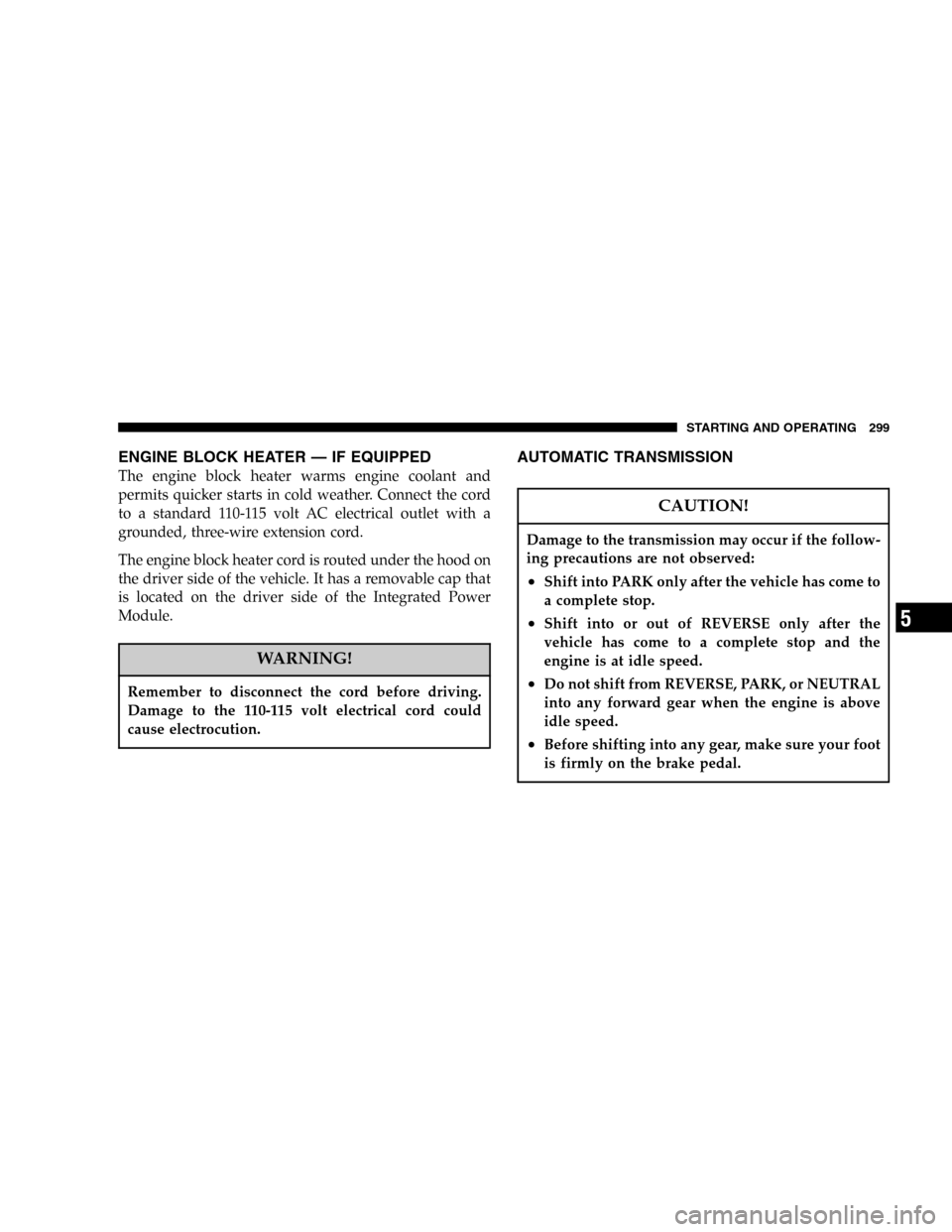Page 273 of 472

A/C Recirculation Programming
The recirculation control is programmed to cancel the
recirculation mode when the ignition key is turned OFF
and will reset to outside air mode when the ignition key
is turned ON. The frequent use of outside air will help
keep odors from building up within the air conditioner-
heater housing. It is recommended that the recirculation
mode be used as little as possible, especially in humid
climates.
For hot and dry climates, or people who are allergic to
pollen and find frequent use of the recirculation mode
necessary, the recirculation mode can be programmed to
not automatically reset to the outside mode by using the
following procedures:
•Turn the ignition switch to the OFF position.
•Set the mode control to“PANEL”.
•Depress and hold in the“Rear Wipe/Wash”button.
•Start the engine, and continue to hold in the“Rear
Wipe/Wash”button until the indicator light starts
flashing repeatedly.
•Press the recirculation button until the indicator light
remains lit.
•The selection will be stored when the ignition switch is
turned OFF or if the“Rear Wipe/Wash”button is
pressed.
If the recirculation indicator light is lit, the recirculation
mode will not reset when the engine is started. If the
recirculation indicator light is not lit, the recirculation
mode will reset to the outside air mode when the engine
is started. The programmed status can be changed back
and forth by following the above mentioned procedure.
UNDERSTANDING YOUR INSTRUMENT PANEL 273
4
Page 275 of 472

Only when the primary control for the rear blower is in
the“REAR”position do the second seat occupants have
control of the rear blower speed.
The rear blower control, located in the headliner near the
center of the vehicle has an OFF position and 3 blower
speed positions. This allows the second seat occupants to
control the volume of air circulated in the rear of the
vehicle.CAUTION!
Interior air enters the Manual Rear Zone Climate
Control system through an intake grille located in
the passenger side trim panel behind the third seat.
The heater outlets are located in the passenger side
trim panel just behind the sliding door. Do not block
or place objects directly in front of the inlet grille or
heater outlets. The electrical system could overload
causing damage to the blower motor.
Rear Temperature And Mode Control
When the center knob on the front climate control unit is
set to the“REAR”position, the second seat occupants
have control of the rear temperature and modes as
follows:
•The rear temperature knob controls both the rear
temperature and mode. When the temperature knob is
UNDERSTANDING YOUR INSTRUMENT PANEL 275
4
Page 285 of 472

Rear Blower Control
The rear blower control, located in
the headliner near the center of
the vehicle has an“OFF”,
“AUTO”and a range of blower
speeds.
The rear blower control knob can be manually set to
“OFF”or any fixed blower speed by rotating the knob
from low to high. This allows the rear seat occupants to
control the volume of air circulated in the rear of the
vehicle.CAUTION!
Interior air enters the Rear Automatic Temperature
Control System through an intake grille located in
the passenger side trim panel behind the third seat.
The heater outlets are located in the passenger side
trim panel just behind the sliding door. Do not block
or place objects directly in front of the inlet grille or
heater outlets. The electrical system could overload
causing damage to the blower motor.
Rear Temperature Control
To change the temperature in the rear of the vehicle, press
the temperature control button down for cold and up for
heated air.
UNDERSTANDING YOUR INSTRUMENT PANEL 285
4
Page 287 of 472

glycol antifreeze coolant in water is recommended. Refer
to section 7, Maintenance Procedures, of this manual for
proper coolant selection.
Winter Operation
To insure the best possible heater and defroster perfor-
mance, make sure the engine cooling system is function-
ing properly and the proper amount, type, and concen-
tration of coolant is used. Refer to section 7, Maintenance
Procedures, of this manual for proper coolant selection.
Use of the air Recirculation mode during winter months
is not recommended because it may cause window
fogging.
Vacation Storage
Anytime you store your vehicle, or keep it out of service
(i.e. vacation) for two weeks or more, run the air condi-
tioning system at idle for about five minutes in the fresh
air and high blower setting. This will insure adequatesystem lubrication to minimize the possibility of com-
pressor damage when the system is started again.
Window Fogging
Vehicle windows tend to fog on the inside in mild rainy
or humid weather. To clear the windows, select�defrost�
or�mix�mode and increase the front blower speed. Do
not use the Recirculation mode without A/C for long
periods as fogging may occur.
Outside Air Intake
Make sure the air intake, located directly in front of the
windshield, is free of obstructions such as leaves. Leaves
collected in the air intake may reduce airflow and if they
enter the plenum they could plug the water drains. In
winter months make sure the air intake is clear of ice,
slush and snow.
UNDERSTANDING YOUR INSTRUMENT PANEL 287
4
Page 293 of 472
STARTING AND OPERATING
CONTENTS
�Starting Procedures.....................296
▫Normal Starting......................296
▫Extremely Cold Weather
(Below�29°COr�20°F) ...............296
▫If Engine Fails To Start.................297
▫After Starting........................298
�Engine Block Heater—If Equipped.........299
�Automatic Transmission..................299
▫Brake/Transmission Interlock System.......300▫Automatic Transmission Ignition
Interlock System......................300
▫Four Speed Automatic Transmission........300
�Parking Brake.........................303
�Brake System..........................304
▫Anti-Lock Brake System—If Equipped.....305
�Power Steering........................307
�Traction Control—If Equipped............308
�Tire Safety Information...................310
5
Page 296 of 472

STARTING PROCEDURES
CAUTION!
Long periods of engine idling, especially at high
engine speeds, can cause excessive exhaust tempera-
tures which can damage your vehicle. Do not leave
your vehicle unattended with the engine running.
WARNING!
Do not leave animals or children inside parked
vehicles in hot weather; interior heat build up may
cause serious injury or death.
The gear selector must be in the NEUTRAL or PARK
position before you can start the engine. Apply the brakes
before shifting into any driving gear.
Normal Starting
Normal Starting of either a cold or a warm engine is
obtained without pumping or depressing the accelerator
pedal. Turn the key to the“START”position and release
when the engine starts. If the engine has not started
within 3 seconds, slightly depress the accelerator pedal
while continuing to crank. If the engine fails to start
within 15 seconds, turn the key to the“OFF”position,
wait 10 to 15 seconds, then repeat the normal starting
procedure.
Extremely Cold Weather
(Below�29°Cor�20°F)
To insure reliable starting at these temperatures, use of an
externally powered electric engine block heater (available
from your dealer) is recommended.
296 STARTING AND OPERATING
Page 299 of 472

ENGINE BLOCK HEATER—IF EQUIPPED
The engine block heater warms engine coolant and
permits quicker starts in cold weather. Connect the cord
to a standard 110-115 volt AC electrical outlet with a
grounded, three-wire extension cord.
The engine block heater cord is routed under the hood on
the driver side of the vehicle. It has a removable cap that
is located on the driver side of the Integrated Power
Module.
WARNING!
Remember to disconnect the cord before driving.
Damage to the 110-115 volt electrical cord could
cause electrocution.
AUTOMATIC TRANSMISSION
CAUTION!
Damage to the transmission may occur if the follow-
ing precautions are not observed:
•Shift into PARK only after the vehicle has come to
a complete stop.
•Shift into or out of REVERSE only after the
vehicle has come to a complete stop and the
engine is at idle speed.
•Do not shift from REVERSE, PARK, or NEUTRAL
into any forward gear when the engine is above
idle speed.
•Before shifting into any gear, make sure your foot
is firmly on the brake pedal.
STARTING AND OPERATING 299
5
Page 347 of 472

IF YOUR ENGINE OVERHEATS
In any of the following situations, you can reduce the
potential for overheating by taking the appropriate ac-
tion.
•On the highways—Slow down.
•In city traffic—While stopped, put transmission in
neutral, but do not increase engine idle speed.
NOTE:There are steps that you can take to slow down
an impending overheat condition. If your air conditioner
is on, turn it off. The air conditioning system adds heat to
the engine cooling system and turning off the A/C
removes this heat. You can also turn the Temperature
control to maximum heat, the Mode control to floor, and
the fan control to High. This allows the heater core to act
as a supplement to the radiator and aids in removing heat
from the engine cooling system.
CAUTION!
Driving with a hot cooling system could damage
your vehicle. If temperature gauge reads“H”, pull
over and stop the vehicle. Idle the vehicle with the
air conditioner turned off until the pointer drops
back into the normal range. If the pointer remains on
the“H”, turn the engine off immediately, and call for
service.
WHAT TO DO IN EMERGENCIES 347
6